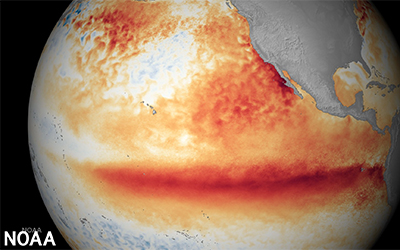
Analysis of ENSO's response to unforced variability and anthropogenic forcing using CESM
B. Vega-Westhoff and R. L. Sriver
Scientific Reports (22 December 2017)
Understanding how the El Niño-Southern Oscillation (ENSO) may change with climate is a major challenge, given the internal variability of the system and relatively short observational record. Here we analyze the effect of coupled internal variability on changes in ENSO under anthropogenic global warming using the Community Earth System Model (CESM). We present results from a ~5000 year control run with constant pre-industrial conditions and a 50-member climate change ensemble experiment, consisting of historical hindcasts (1850-2005) and future projections to 2100 following representative concentration pathway 8.5 (RCP8.5). Given this large single-model ensemble, we are able to use simple statistical analyses to compare the effects of anthropogenic climate change with the effects of natural modulations in ENSO sea surface temperature (SST) metrics, as well as how internal variability may change with global warming. Changes in eastern Pacific ENSO SST metrics due to climate change are secondary to the model's natural modulations; however, central Pacific ENSO amplitude significantly decreases, to an extent comparable with natural modulations. We also assess the sensitivity of internal variability estimates to ensemble size. The primary role of natural modulations in this ensemble highlights the importance of careful assessment of ocean-atmosphere internal variability in ENSO projections.
additional materials:
summary slide | DOE highlight | open access manuscript